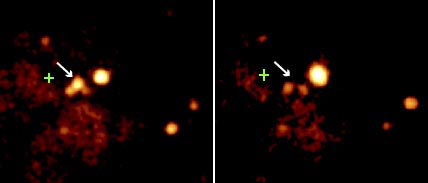
The central 4,000 light-years of the galaxy M82 as seen in X-rays. Note the arrowed source, which turned off in the three months between these pictures. Such radical variability is one reason to think it's a black hole. The green cross marks the galaxy's center of mass, which is located at least 600 light-years from the object.
Courtesy NASA / SAO / CXC.
Black holes are supposed to come in two very different sizes. Some have just a few times the mass of our Sun; nearly all astronomers think these are created in core-collapse supernovae. And at the centers of most galaxies are titanic black holes having millions to billions of solar masses.
But in between lies a vast gap of doubt about "intermediate-mass" black holes, which would contain hundreds to thousands of times the Sun's mass. There's no obvious, direct way for such objects to form. But there have been controversial signs that they exist. Two studies described this week at a meeting of the American Astronomical Society's High-Energy Astrophysics Division at Mount Tremblant, Quebec, may sway some skeptics.
Both projects examined so-called "ultraluminous X-ray sources," or ULXs, that speckle nearby galaxies. These pinpoint beacons probably arise from hot disks of inspiraling matter accreting onto black holes. ULXs are so bright, some astronomers have claimed, that they must represent unusually large accretion disks around black holes containing thousands of solar masses. Other astronomers, however, have pointed out that smaller, ordinary accretion disks could appear this bright if they managed to focus most of their X-rays in a narrow beam toward us. The new research, using the European Space Agency's XMM-Newton satellite, confronts that objection head-on.
One team, led by Jon Miller (Harvard-Smithsonian Center for
Astrophysics), studied two ULXs in NGC 1313, a spiral galaxy about 12 million light-years away in the constellation Reticulum. X-ray spectra show that the innermost parts of the two accretion disks must have a surprisingly low temperature: about 1 million degrees Kelvin, rather than the 10 million degrees typical of stellar-size accretion disks. A lower temperature, paradoxically, indicates a more massive hole. The fabric of space-time curves more gently around a big hole than a small one, Miller notes, so the gas spiraling in doesn't get as hot before it disappears. The team calculates that the two black holes in NGC 1313 each pack about 1,000 solar masses.
Moreover, X-ray images reveal nebulae being lit up around these ULXs — showing that radiation streams from them in all directions, not just toward Earth.
Another team looked at an especially bright ULX in M82, a starburst galaxy in Ursa Major at about the same distance. XMM-Newton found regular, 18-second oscillations in the intensity of the X-rays, the first such fluctuations seen in a source outside the Milky Way. These characteristic oscillations may come from hot clumps orbiting the black hole or perhaps from the entire disk throbbing in some way. In any case they nail the case for an accretion disk, says study leader Tod Strohmayer (NASA/Goddard Space Flight Center). Moreover, he emphasizes, radiation from such a disk couldn't beam in one direction.
Spectra of the M82 object taken by XMM also revealed a distinctive feature called a broad iron K line. It indicates that the X-ray emission from highly ionized iron atoms is greatly Doppler shifted by high-speed motions around the hole — and also by the gravitational redshift of the hole's intense pull. The prominence of this spectral feature, the total output of X-rays, and the lack of beaming all point to a mass of 500 Suns, Strohmayer says.
The new evidence makes it harder to devise alternatives to intermediate-mass black holes, comments Philip Kaaret (Harvard-Smithsonian Center for Astrophysics). Still, he notes, the pair of studies is puzzling because the disk in M82 seems far hotter than the two in NGC 1313. "It's a little too early to say that this is definitive proof," Kaaret observes.
 0
0
Comments
You must be logged in to post a comment.